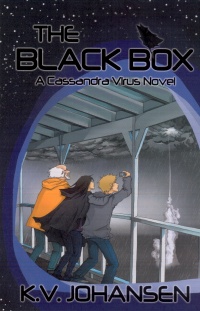| ________________
CM . . . . Volume XVII Number 22. . . .February 11, 2011.
excerpt: The van loomed over them. It looked very new: a fuel-cell model, of course. Electric was only useful for little commuter cars. Folded down on the roof was a lot of equipment. There wasn't time to figure out what it all was: sensors, receivers, transmitters, or maybe all three. Jordan took pictures of the van from the side and front, moved around to take the rear, and a close-up of the licence plate. Virginia. That was interesting, as Cassandra would say. Some of the American security agency headquarters were in Virginia.
"Pass up the camera." Helen had climbed halfway up a ladder to the haymow. "No, Ajax. Come. Sit. Stay. . . . I'll take a couple of pictures of the gear on the roof from above. Cassandra should be able to figure out what it's all for from that."
"Be quick." . . . Jordan moved off towards the main door, to listen for sounds of anyone leaving the house.
This took him right past the small door into the end section Ajax had been so interested in.
"So you work for Cassandra," hissed a voice in his ear, and someone seized his arm. "Don't move. Don't make a sound."
The Black Box is Johansen's third book about Jordan, Helen, and the sentient virtual supercomputer Cassandra. It is set in the near future and combines elements of sci fi with a humorous spy/adventure story. Archaeologist Uncle William uncovers a strange black object that looks like a rock, but it appears to be connected to the periodic blackouts of all wireless communication in the area and to the malfunctioning of the Mars Relay satellite. It has attracted the attention of a group of people who are pretending to be birdwatchers but are clearly American spies, and Jordan, Helen, and their new allies, Demetrios and Arielle, determine to find out what the black object is before some governmental agency, domestic or foreign, can take it away. Jordan writes a program that allows Cassandra to communicate with the Black Box, and she discovers that it is an alien probe. With the help of Demetrios and Arielle's historical re-enactment club, the kids hold off the American spies long enough for the probe to return to its mother ship. Cassandra copies herself into the probe's memory so that she can make first contact with the probe's senders, who are safely 46 light-years away.
Highly Recommended. Kim Aippersbach is a freelance editor and writer with three children in Vancouver, BC. Copyright © the Manitoba Library Association. Reproduction for personal use is permitted only if this copyright notice is maintained. Any other reproduction is prohibited without permission.
NEXT REVIEW |
TABLE OF CONTENTS FOR THIS ISSUE- February 11, 2011.
AUTHORS |
TITLES |
MEDIA REVIEWS |
PROFILES |
BACK ISSUES |
SEARCH |
CMARCHIVE |
HOME |
